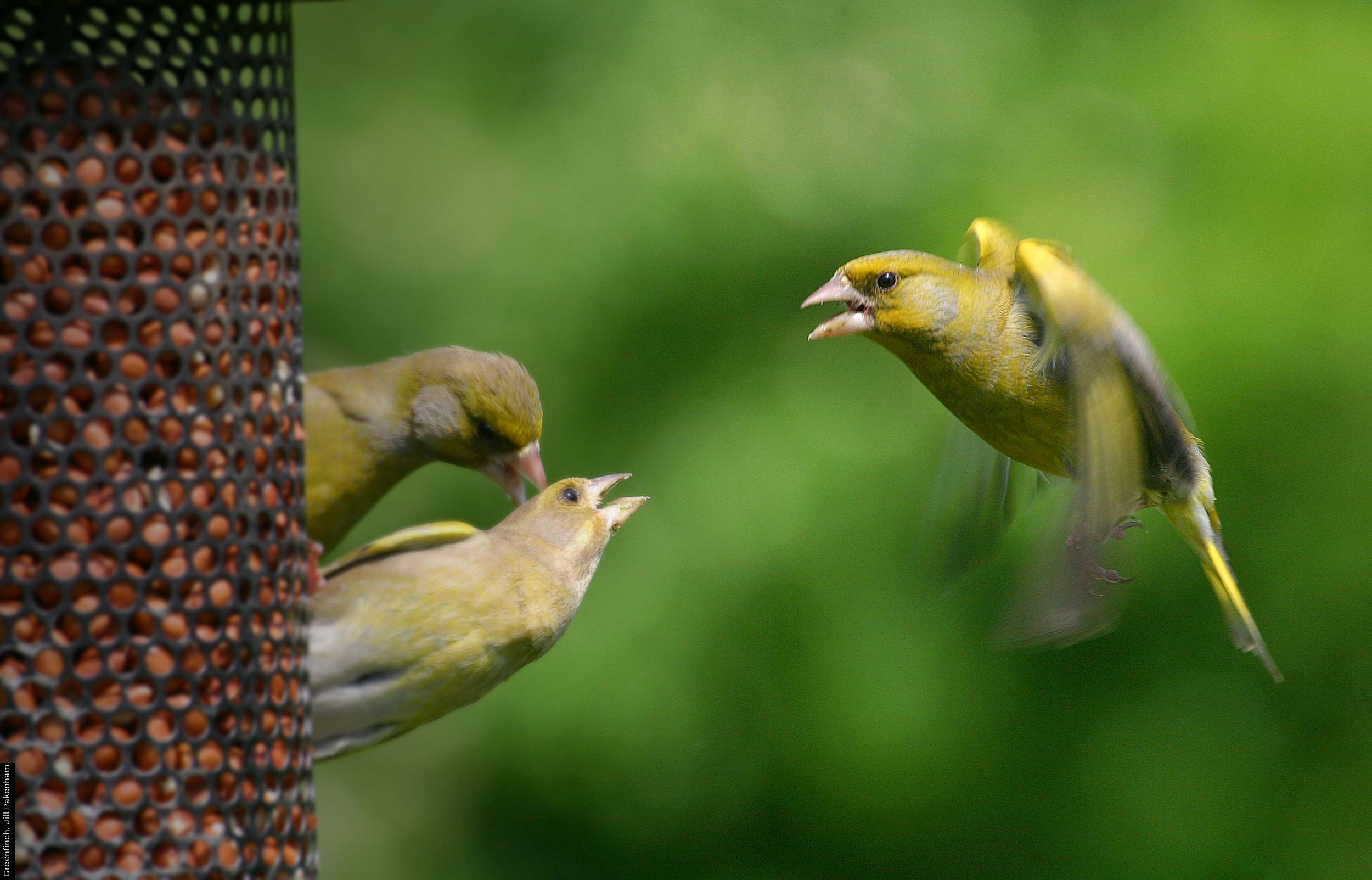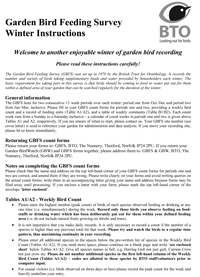Instructions
Summary
Householders make observations from October to March inclusive, with the maximum number of each species seen using food or water provided (or observed hunting the birds that are using these resources) recorded on a weekly basis.
In addition to counts of birds, participants log the foods that have been provided in each week and there is also space for additional comments.
Garden Bird Feeding Survey
Winter Instructions for participants
The basic requirement for participation in this survey is that birds should be coming to food or water put out for them within a defined area of your garden that can be watched regularly for the duration of the winter.
PLEASE NOTE THAT, UNLIKE GARDEN BIRDWATCH, THERE IS NO SPECIAL CATCH-UP WEEK IN DECEMBER FOR THE GBFS SURVEY. GBFS RUNS OVER THE NORMAL 26-WEEK WINTER PERIOD.
General information
The GBFS lasts for two consecutive 13 week periods over each winter: period one from Oct–Dec and period two from Jan–Mar, inclusive. Please fill in your GBFS count forms for periods one and two, providing a weekly bird count and a record of feeding units (Table A1/A2), and a table of weekly comments (Table B1/B2). Each count week runs from a Sunday to a Saturday inclusive – a calendar of count weeks in periods one and two is given above Tables A1 and A2, respectively. The date when the GBFS counts start changes every year. If you are unsure of when to start, please contact gbw [at] bto.org. Your GBFS site number (see your cover letter) is used to reference your garden for administration and data analysis. If you move your recording site, please let us know immediately.
Returning GBFS count forms
Please return your forms to: GBFS, BTO, The Nunnery, Thetford, Norfolk IP24 2PU. If you return your Garden BirdWatch (GBW) and GBFS forms together, please address them to: GBFS & GBW, BTO, The Nunnery, Thetford, Norfolk IP24 2PU.
Notes on completing the GBFS count forms
Please check that the name and address on the top left-hand corner of your GBFS count forms for periods one and two are correct, and amend them if they are wrong. Please write clearly on your forms and avoid writing queries on the actual count forms; write them in an accompanying letter giving your name and address because forms may be filed away until processing. If you enclose a letter with your form, please mark the top left-hand corner of the envelope ‘letter enclosed’.
Tables A1/A2 - Weekly Bird Count
• Please enter the highest number (peak count) of birds of each species observed feeding or drinking at any one time (i.e. simultaneously) during the week. Record only those birds you observe feeding on food-stuffs or drinking water which has been deliberately put out for them within your defined feeding area (i.e. do not include natural fruits growing on shrubs and trees).
• It is not imperative that you make daily records. It is only necessary to record a count if the number of a species is higher than any previous total for that week. Please try and watch the birds to a regular time pattern, thus maximising continuity in your recording.
• Please enter all additional species in the spaces below the pre-written list of species in the Weekly Bird Count (Tables A1/A2). If you need more space, please continue on a blank page and write ‘see enclosed sheet’ below Tables A1/A2. Give all species names in full, e.g. Herring Gull not just gull, Carrion Crow not just crow etc. Please do not number additional species in the first left-hand column of the Weekly Bird Count (Tables A1/A2) – codes are allotted to these species by BTO staff/volunteers prior to computer input.
• For casual visitors (i.e. birds observed on three days or less) please record the peak count for the week and heavily underline your entry.
• Count as accurately as possible. Please do not use plus signs as we do not know whether it means as little as +1 or as much as +500! When forced to estimate the size of a flock (e.g. Starlings) enclose the figure in brackets, thus: (25).
• Birds of Prey observed chasing or killing small birds within the defined feeding area should be included in the Weekly Bird Count (Tables A1/A2).
• Marsh and Willow Tits have been bracketed together owing to difficulty of identification. If, however, you are quite certain of the species identity, please enter the species in the additional spaces below the pre-written list of species in the Weekly Bird Count Table (Tables A1/A2).
• Feral Pigeons coming to take food should be included.
• Remember to include in your counts birds coming to drink
• If for any reason (such as holidays or illness) your coverage has been reduced, cross off the appropriate week column heading in Tables A1/A2 and write a corresponding note in the Weekly Comments section (Tables B1/B2). Please draw a line in pen down the column in Tables A1/A2 of the week number that you were unable to record, so that subsequent records are put in the correct week column and to facilitate our inputting of your data. Note, please do not do this on your normal Garden BirdWatch count forms!
• Please use a black or dark blue pen, NOT pencil, and complete names of additional species in capitals.
TIP: A convenient method of recording the peak weekly count for each species is to use a kitchen slate (shopping reminder type) or a cheap notebook. Write a list of likely birds down the left-hand side of the slate or on the left-hand page of the notebook and, starting on Sunday, record the highest number of birds of each species seen feeding at any one time during that day. Repeat this for each subsequent day of that week, then at the end of the week select the highest number and enter this on the GBFS count form.
Tables A1/A2 - The Record of Feeding Units
Please indicate the number of feeding units at three different feeding positions: (i) Hanging, (ii) Table or Raised Surface, (iii) Ground. Where no food is provided leave the column blank. Please use numbers in the relevant cells, rather than ticks or crosses. For clarity, please fill in the feeder unit information for every week that you record, even if the feeding units remain the same as in the preceding week. Where you provide more than one feeding unit of the same type, the distance between them should be as great as your circumstances will allow, particularly in the case of ground units. This need not apply to units of different types, for instance, a nut feeder (1 unit) can be suspended from a bird table (1 unit). A description of the feeding positions and units are:
• Hanging feeders (wire/plastic), 1 unit each.
• Fat and/or bones when hung at separate points, 1 unit each.
• Raised bird table(s) and old tree stump etc, 1 unit each.
• Ground – an area about 4 ft x 4 ft over which food is scattered, 1 unit each.
Tables B1/B2 - Weekly Comments
Tables B1/B2 consist of a series of boxes numbered for brief comments relating to the week's observations.
• Of particular interest are comments relating to the weather conditions, such as prolonged rain, fog, frost and snow which may have affected the number of birds coming to feed.
• Please comment if for any reason (such as holidays or illness) your coverage has been reduced.
• If you see any unusual species feeding on foods provided, please state the species and what food was taken in the weekly comments. For any rare species observed please supply a detailed description of appearance and behaviour.
If you have any problems or queries please contact: GBFS, BTO, The Nunnery, Thetford, Norfolk, IP24 2PU; Tel. 01842 750050; gbw [at] bto.org







Share this page